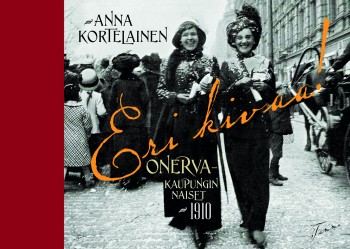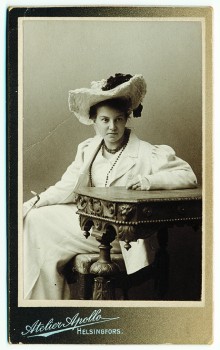Women and the city
17 April 2010 | This 'n' that
How was city life for the single woman a hundred years ago in Helsinki?
She could ride a bike, for example, provided it was equipped with an ‘alarm system’ and the speed was not high. Socially she could have fun as long as she obeyed the rules. No admittance to restaurants without male company, for example.
Some young women in those days had to make a living by teaching or by working in an office – before they got married, of course.
A new exhibition (25 March–29 August) at Helsinki’s Ateneum art museum, entitled Kaupungin naiset (‘Women of the city’), focuses on the cultural life of young women in Helsinki in the 1910s through the eyes of the writer and critic L. Onerva (aka Hilja Onerva Lehtinen, 1882–1972).
The curator of the exhibition, writer and art historian Anna Kortelainen, is also the editor of the book Eri kivaa! Onerva – kaupungin naiset 1910 (‘Jolly good! Onerva – women of the city, 1910’, graphic design by Anders Carpelan, Tammi 2010).
In this large illustrated album, Kortelainen introduces us to Onerva’s Helsinki: streets and parks, people and everyday life, art galleries, films and cinemas, cafés, restaurants, theatre premieres, concerts and other social events.
L. Onerva studied art history at university, wrote reviews, poems and novels, painted, lived on her own, travelled abroad, enjoyed the cultural scene of the city and had an active social life.
Between 1901–1918 she was in turn single, married and divorced, and had lovers – among them the poet Eino Leino (1878–1926). Life was not easy for an independent working woman – there were debts, limited freedom, moral judgement.
Onerva’s second marriage, to the composer Leevi Madetoja (1887–1947), was finally ruined by alcohol; both were at times admitted to mental hospitals.
She was extremely creative all her life, but after 1952 she didn’t publish anything. When she died, at the age of 89 in a mental hospital, among her artistic legacy she left thousands of self-portraits and more than a hundred thousand poems.
Tags: art, biography, Helsinki, literary history
1 comment:




20 April 2010 on 7:09 am
Oh to be in Helsinki this summer to see the show at the Ateneum. Independent women of Finland seem more, or at least as, free as their contemporaries in the USA, at the same time. I want to learn more….